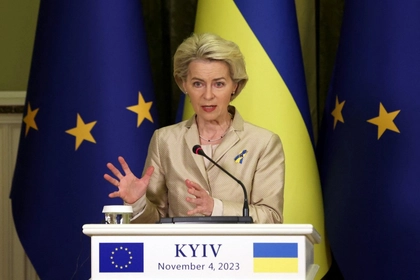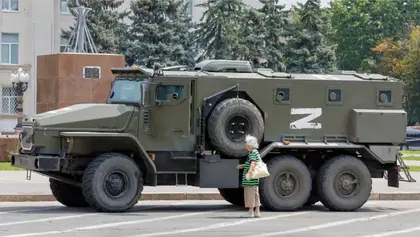Vladimir Putin has been making loud announcements lately, practically once a week, all of them related to the war against Ukraine and aimed at escalating it further. His latest decree of Oct. 19 is no exception. Putin had been expected to declare martial law at least in those regions bordering on Ukraine, if not countrywide, but he did it differentially: he imposed martial law in four temporarily occupied and recently annexed regions of Ukraine and a “medium-level response mode” in the regions bordering on Ukraine and in Crimea and Sevastopol.
Putin also ordered the authorities in the regions within the Central Federal District and the Southern Federal District to switch to “high alert mode”. The “medium-level response mode” and “high alert mode” are sort of light versions of martial law. Actually, Russians are thus being prepared for martial law (as they were gradually prepared for mobilization which is still called “partial”), while local authorities have time to practice the measures required under martial law.
JOIN US ON TELEGRAM
Follow our coverage of the war on the @Kyivpost_official.
There is nothing extraordinary or new about martial law in occupied Ukrainian territories: the Donbas industrial region has been in a state of war since 2014 and the southern regions since February 24, 2022 (neither Donbas nor the southern regions have been occupied completely by Russian forces). Moreover, in the so-called “Donetsk People’s Republic” (DNR) and “Luhansk People’s Republic” (LNR) and in the occupied parts of Kherson and Zaporizhzhia Regions martial law was introduced by their Moscow-installed authorities. Now martial law has been legitimized under Russian legislation.

EU Transfers €1.5 Bln Raised From Russian Assets for Ukraine
This appears to be just a formal procedure for legally reconfirming the annexation of the occupied Ukrainian regions – another way to flag them as their own, but there is a political context.
It is coincidence that several hours before Putin signed his decree, Gen. Surovikin, the newly-appointed commander of Russian forces in Ukraine, said on Russian state television that the situation in Kherson was “extremely difficult” and that “difficult decisions cannot be avoided “.
His comments came shortly after the Moscow-installed officials in Kherson Region announced a mass evacuation from the city of Kherson as well as towns and villages on the right bank of the Dnipro River. It all looked very much like a prelude to the Russians’ flight from Kherson (which they might again call “a goodwill gesture”). But how can this “goodwill” be explained or substantiated to Putin’s fans in Russia, who so joyously and pompously hailed the annexation of this territory just three weeks ago? And how can another splash of harsh criticism from Russian political hardliners and military hawks be dodged?
Putin needs to show – at least formally – that he will not give up on these territories without a fight. As fighting continues in all four regions, such a demonstration looks relevant to all.
Of course, there must have been other reasons for declaring martial law in occupied Ukrainian regions. Oleksiy Danilov, Secretary of the National Security and Defense Council of Ukraine, said that “Putin’s martial law in the annexed regions of Ukraine is groundwork for mass deportation of Ukrainians to Russia’s depressive regions, intended to change the demographic composition of the occupied territories. The crime which must be condemned by the United Nations and which Russia earlier committed in Crimea remains unpunished.” We can see indications of Moscow’s plan to deport residents of the city of Kherson and some areas of the region to Russian territory under the guise of evacuation. The same has already happened to residents of Mariupol and other destroyed cities and villages in the Donbas.
The Ukrainian Foreign Ministry also claims Putin declared martial law to quench local resistance.
Finally, it boils down to legalizing any harsh measures that have been and will be taken by the occupation authorities and legitimizing the very fact of war against Ukraine on Ukrainian territory. Putin promised peace and prosperity to residents of the cities and villages he has occupied and annexed. Instead, they got martial law, continued and escalating war, as well as deportation. They may well lose their property since martial law gives Russian occupiers a free hand to loot and maraud by permitting them to use civilian property for military purposes.
Putin’s martial law also warrants total mobilization in the occupied territories (though there are in fact practically no men left to mobilize in the DNR and LNR). The Russian military are now permitted to do anything they like, while civilians have to survive under severe restrictions.
Putin’s decrees will definitely have no effect on the course of the war or the future of the temporarily-occupied Ukrainian territories. The Ukrainian Foreign Ministry has stated in no uncertain terms that “Putin’s decree is null and void and bears no legal consequences whatsoever for Ukraine and its citizens as well as for the international community. This step highlights yet another crime against the state and people of Ukraine committed by the Russian leadership.”
The U.S., Germany and many other countries have condemned Putin’s martial law in the occupied Ukrainian territories and reconfirmed the illegality of their annexation.
Meanwhile, Ukraine is responding in the best way it can – by gradually and consistently clearing its cities and villages of Russian occupiers. Kherson is next in line, and yet more will follow!
The views expressed in this article are the author’s and not necessarily those of Kyiv Post.
You can also highlight the text and press Ctrl + Enter






